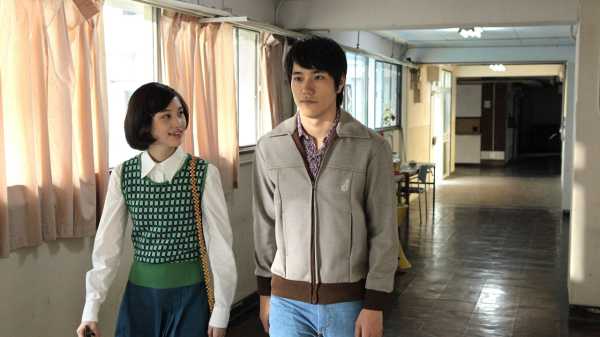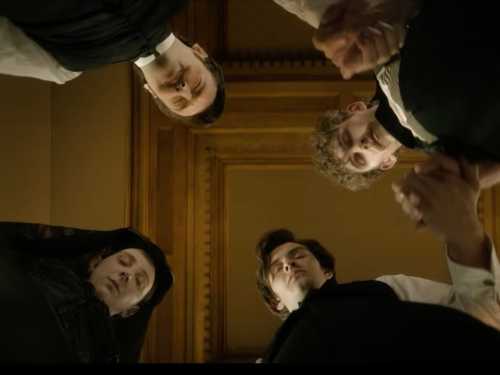
For enthusiasts of Haruki Murakami, last month brought two major events in two different countries. One is the publication, in Japan, of his latest novel, “Machi to Sono Futashika na Kabe” (“The City and Its Uncertain Walls”). The other is the release, in the United States, of “Saules Aveugles, Femme Endormie” (“Blind Willow, Sleeping Woman”), an animated feature based on several of Murakami’s short stories. In contrast to “The City and Its Uncertain Walls,” about which almost all information was withheld from the public before it went on sale, “Blind Willow, Sleeping Woman” has been publicized with all the means available to a production of its modest scale, including a trailer that emphasizes a host of identifiable pieces of Murakamiana: prowling cats, ethereal sex, dense Japanese urban landscapes, an absent wife, a descent into darkness, and a talking humanoid frog.
That last creature appears in Murakami’s short story “Super-Frog Saves Tokyo,” and it’s vaguely disconcerting to hear it speaking English—or French, for that matter, in the film’s original trailer. A French Luxembourgian Dutch Canadian co-production, “Blind Willow, Sleeping Woman” was directed by the composer-filmmaker Pierre Földes, whose official Web site says he was “born in the U.S. to Hungarian/British parents” but “raised in Paris.” Despite lacking any obvious connection to Japan—Murakami’s homeland, and usually his setting—Földes comes off as just the sort of international figure likely to be inspired by Murakami’s work. In adapting that work for the screen, he adds another volume to the saga of Murakami in the movies, which, like one of the writer’s own increasingly elaborate, oddity-filled novels, compensates for its frequent lapses into inelegance with the sheer fascination of aesthetic, cultural, and linguistic incongruity.
Murakami baked that incongruity into his writing from the very beginning. In his late twenties, while running a jazz bar in Tokyo, he decided to become a novelist. He felt dispirited by the stilted dullness of the manuscript produced during his first few months of writing, and he attempted to cast off the literary mannerisms that he’d unconsciously adopted by rewriting the novel’s opening in what English he then commanded (much of which would likely have come from the cheap hard-boiled paperbacks he’d found in used bookshops during his youth, in the port city of Kobe). When Murakami “translated” his writing back into Japanese, “the result was a rough, uncultivated kind of prose,” as he puts it in the memoir “Novelist as a Vocation.” “As I struggled to express myself in that fashion, however, a distinctive rhythm began to take shape.”
The career-making début novel that resulted, “Hear the Wind Sing,” was published in Japan, in 1979, and a cinematic adaptation followed, in 1981. When the director of that film, Kazuki Ōmori, experienced frustrations of his own in the screenwriting process, he, too, solved them by borrowing a foreign syntax. “You cannot just let actors recite lines from Murakami’s novels, because no Japanese person actually talks like his characters do,” he told the Asahi Shimbun, in 2013. Murakami’s dialogue read to him more like Japanese subtitles below a Western film, which, along with the novel’s short, fragmented chapters, gave him an idea: “I decided, Let’s make a Godard film,” complete with oblique title cards and jarring visual transitions. But the resulting piece of Nouvelle Vague à la japonaise failed at the box office, and Ōmori, who died last year, is better remembered today for his “Godzilla” movies.
Ōmori’s “Hear the Wind Sing” remains an obscurity four decades later, but one whose formal playfulness, imitative at the time, now feels almost fresh again. Its brief, episodic scenes follow the novel’s desultory events, many of them having to do with the beers the protagonist drinks—and the troubled young women he encounters—as a college student back home in Kobe during the summer of 1970. (The form of the novel was dictated by Murakami’s writing schedule, a few hours each night after closing the bar.) But the film as a whole is even more faithful to the novel’s atmosphere: every Murakami reader will recognize the texture of more or less genial alienation, foggily dissociated from politics, in which his characters live. They listen to jazz and classical music, get into conversations punctuated with broad pronouncements (“Civilization means transmission. Whatever can’t be expressed might as well not exist”), and confine their cultural references almost entirely to things Western.
A mutual friend, the writer Roland Kelts, once explained to me that Murakami has achieved enduring worldwide popularity because he “creates his own genre.” The tropes of that genre are by now firmly established (or too firmly established, as detractors would argue). But a Westerner who happened to see “Hear the Wind Sing” in the early nineteen-eighties, when Murakami was still largely unknown outside Japan, would have found it a strange brew indeed. How curious, for instance, that the record which the protagonist struggles to give to an old classmate, having borrowed it five years before, isn’t a Japanese hit of 1965 but the Beach Boys’ “California Girls.” The song takes on enough importance to the novel’s narrative, such as it is, that it couldn’t have gone unheard in the movie, and the likely stiff licensing fees for the other popular songs Murakami drops into his work could have scared off potential adapters in the subsequent decades.
According to Ōmori, Murakami was reluctant to give his blessing to more feature films. In 1982 and 1983, the young filmmaker Naoto Yamakawa turned Murakami’s “The Second Bakery Attack” and “On Seeing the 100% Perfect Girl One Beautiful April Morning” into charming shorts, neither of which departs significantly from the writing that inspired it. But, when Jun Ichikawa adapted the story “Tony Takitani” at full length much later, in 2004, he did so with a near-religious adherence to the text, turning some of Murakami’s words into voice-over narration and illustrating the film with spare, closely framed images (all to a lushly desolate score by the late Ryuichi Sakamoto). Even the casting is minimal: Issey Ogata takes on the dual role of both the title character, a passive but highly competent technical illustrator, as well as his father; Rie Miyazawa plays both Tony’s fashion-addict wife and the young woman he considers hiring as an assistant after his wife’s sudden death.
“Tony Takitani” is something of a parable of postwar Japan, which by the time of the story’s original publication, in the early nineteen-nineties, had become one of the world’s wealthiest countries, albeit one viewed as a place of unimaginative, culturally dislocated ostentation. Born, like Murakami himself, in the late nineteen-forties, the central character gets his unusual name from a U.S. military officer acquaintance of his jazz-musician father, who figures its “American” sound will be advantageous under the new postwar order. Murakami, for his part, got the name from a T-shirt he found at a Maui thrift store, as he explains in his recent essay collection, “Murakami T.” The “Tony” Takitani emblazoned on its chest was a Hawaiian politician, but the striking combination of given name and surname got Murakami imagining a mild, taciturn Japanese man of his generation, hardworking and successful but persistently ill at ease with his place in the world.
A similarly complex cultural situation is suggested by the name of Kengo, the young man at the center of “All God’s Children Can Dance,” the Swedish Canadian director Robert Logevall’s 2008 adaptation of Murakami’s eponymous short story. The first non-Japanese feature film based on Murakami’s work, it transplants Kengo from Tokyo to Los Angeles. Riding the bus through the industrial outer reaches of that city, Kengo talks with an elderly woman sitting nearby. “Are you Japanese?” she asks. “No, I’m American. I’m from here.” “With a Japanese name?” “Uh-huh. But I’m Chinese.” When she asks if he lives in Chinatown, he explains that, actually, he lives in Koreatown. He lives there, he does not add, with his mother, a zealous member of a quasi-Christian sect who insists that her son—with whom her own relationship hovers at the edges of the Oedipal—is the product of immaculate conception.
Having rejected his mother’s faith, Kengo believes that his father is not God but, rather, an obstetrician with one mangled ear. After spotting a man matching that description in a restaurant, he surreptitiously follows him down into the subway. In Murakami’s story, this pursuit starts near Kasumigaseki, heading toward the Chiyoda Line; in Logevall’s film, Kengo shadows the man on a northbound train heading for the San Fernando Valley. As a former Koreatown resident, I was delighted to see this sequence begin in my old home subway station but also to see the neighborhood depicted as the lurid urban palimpsest I knew: of the prewar heyday of Brown Derby and the Ambassador Hotel, of subsequent waves of immigration from Asia and Latin America, of relatively aggressive twenty-first-century high-rise development. All this made Koreatown feel, in my years in Los Angeles, like a rare Murakamian zone outside Japan.
A viewer’s enjoyment of “All God’s Children Can Dance” will be heightened by familiarity with its setting, and—as with most Murakami adaptations—even more so by familiarity with the source material. Murakami’s dialogue may sound unnatural when delivered by Japanese actors, but it hardly improves in that respect when delivered by non-Japanese ones. In the original story, the protagonist resents having been blessed not with skills as an outfielder (baseball being a common preoccupation among Murakami’s men) but an extra-large phallus. At its best, Murakami’s writing feels like a direct line to his imagination, which makes compelling even his most juvenile or bizarre inventions. But the words of his omniscient narrator lose a certain elegance when approximated by characters onscreen: “I just wanted to catch pop flies,” says a pensive, naked Jason Lew, who plays Kengo in the film. “That’s all I ever prayed for. Instead, God gave me this huge . . . cock.”
“All God’s Children Can Dance” leaves an impression with its mixture of the dingy and the dreamy, though it also bears marks of severe indie-movie resource constraints. Some of its awkwardness can be forgiven for that reason, but “Norwegian Wood”—a 2010 adaptation of the novel of the same name that made Murakami a literary superstar—has no such excuses. A subtly lavish, highly aestheticized period piece, the film re-creates Japan’s heady late nineteen-sixties, the backdrop against which a college student named Toru Watanabe struggles with his simultaneous attraction to two young women: the Naoko, who is receiving treatment in a sanitorium and who was once involved with a friend of Toru’s who died by suicide, and Midori, a spirited classmate who campaigns to win him over with her brazen independence. On its face, this simple tale would seem easily adaptable, not least since, unlike some of Murakami’s novels, it includes no alternate universes, talking cats, or supernatural homunculi.
Yet a viewer who hasn’t read “Norwegian Wood” would find the film barely intelligible, the ironic effect of an adaptation that’s not too loose but, rather, too faithful. For Murakami diehards, it constitutes a string of opportunities to recognize events and characters (the right-wing nerd Storm Trooper, the cad-aesthete Nagasawa) encountered on the page countless times before. Dutifully re-creating the story’s dramatic turns, it exudes even in its sex scenes the kind of clenched seriousness that attends interpretation of a sacred text. Gone is the perspective provided in the novel by the first-person narration of Toru himself—an older Toru, who recalls his youthful romantic agonies in the casually philosophical voice familiar from Murakami’s other writings. Gone, too, is the framing device of Toru being reminded of these experiences by an orchestral version of “Norwegian Wood” heard on an airplane in Hamburg, a characteristic moment of resonant culture clash.
Whether the Vietnamese French director Trần Anh Hùng (another Murakami-inclined filmmaker of dual nationality) was the best candidate to adapt “Norwegian Wood” remains a matter of debate, but he does, at least, represent Murakami’s robust readerships in both Europe and Asia. Murakami commands an especially fervent following in South Korea, where I live, and where many of his fans refer to him by his given name. I used to spend a lot of time at a café in Seoul that boasts shelves filled with the complete works of “Haruki” in Korean translation. One day, I overheard another regular ask its owner what he thought of the “Norwegian Wood” movie, and he answered with just one word: sseuregi. Trash. He had a much higher opinion of a more recent, Korean-made Murakami adaptation: “Burning,” from 2018, directed by one of this country’s most critically acclaimed auteurs, Lee Chang-dong.
Lee expands Murakami’s “Barn Burning,” an unsolvable mystery involving a seemingly wealthy young man who confesses to the unusual hobby of setting fire to barns. In the short story, a flighty young woman who’s acquainted with the narrator brings this character—her new boyfriend—back from a sojourn in Africa, where he was the only Japanese person she knew; before long, she suddenly becomes one of Murakami’s vanished females. “Burning” takes these nameless characters and gives them fuller, Koreanized identities. The narrator becomes Lee Jong-su, an aspiring young novelist who admires William Faulkner; the girl becomes Shin Hae-mi, a childhood neighbor of Lee Jong-su’s since rendered unrecognizable by plastic surgery. The inscrutable barn-burner introduces himself as Ben—with, as Murakami put it, “the firm handshake of a person who'd lived abroad a long time”—and speaks suavely but oddly, in a Korean subtly distorted by unusual inflections and peppered with Anglicisms.
The Korean American actor Steven Yeun plays Ben as a tour de force of ambiguity, embodying both the allure and the essential disreputability attributed in Korea to the foreign in general and the Western in particular. Lee Jong-su occupies an uneasy cultural borderland of his own, living in a dilapidated farmhouse within propaganda-speaker distance of the northern border. “There are too many Gatsbys in Korea,” he complains, smoking on the terrace of Ben’s well-appointed apartment in the French Quarter of Gangnam. Although not taken straight from “Barn Burning,” that line is more than plausibly a reference to Murakami’s work, specifically his translation of F. Scott Fitzgerald’s novel into Japanese. (So, in another way, is Jong-su’s love of Faulkner; “Barn Burning” takes its title from one of his own class-conflict-saturated stories.) The movie even goes so far as to introduce signature Murakamian elements—a well, a cat—not present in the work on which it’s based.
Despite the tributes it pays to Murakami, “Burning” is a thoroughly Korean film, not least in the unexpectedly bloody catharsis with which it ends. (Bong Joon-ho made a similar move the following year, in “Parasite,” and to much greater commercial result.) Daishi Matsunaga’s “Hanalei Bay,” also from 2018, is a thoroughly Japanese film despite its taking place mostly in Hawaii, where Murakami has spent many years, and which he’s used more than once as a setting with the ambience of a culturally “liminal space” (a term that tends to crop up in analyses of his writing) between Asia and North America. In “Hanalei Bay,” a Japanese woman named Sachi is called to Kauai to identify the body of her son, a teen-age surfer who died after a shark attack. Though she admits to having disliked him, perhaps for his laziness and sullen entitlement, she’s drawn repeatedly back to the site of his death.
It surely counted for something, from a filmmaking perspective, that the site is highly picturesque, as well as situated in an exotic but not wholly alien place. (The latter is also the appeal of Murakami’s fictional worlds, with their mixture of the inexplicable and the almost boringly familiar.) Sachi does interact with Americans—most of whom speak in the plodding, faintly narcotized manner common among Western actors in East Asian films—but her most meaningful connection is with a couple of young Japanese surfers whom she pities for their naïveté and ineptitude, qualities not wholly unreminiscent of her own lost boy. Murakami writes the pair as having come to Hawaii under the delusion that they could get by speaking only Japanese; in Matsunaga’s film, one of them does speak English, but reveals that ability only at dramatically opportune moments.
If a work of literature uses multiple languages, it runs a considerable risk of losing the reader; not so for a work of cinema, which can always provide subtitles. Ryûsuke Hamaguchi’s “Drive My Car,” from 2021, is one of the rare films that practically nobody can watch without them. An ambitious adaptation of three of Murakami’s short fictions, it takes from the title story the central dyad of a widowed middle-aged actor (portrayed in the film by Hidetoshi Nishijima, the narrator of “Tony Takitani”) and his rough-edged but consummately professional and highly sympathetic young female chauffeur. But the production of “Uncle Vanya” in which he participates, noted only briefly by Murakami, becomes, in the film, an international collaboration involving actors from across East Asia—Japan, Korea, Taiwan, the Philippines—each of whom speaks only his own native language onstage.
Though not Murakami’s invention, this multilingual “Uncle Vanya” nevertheless feels genuinely Murakamian, and not just because he’s name-checked Chekhov before. Having set himself on the path to becoming the most successful Japanese novelist alive by writing, laboriously, in English, Murakami understands the value of crossing not just cultural but linguistic boundaries. His books have now been published in some fifty languages, which suggests that the appeal of his writing resides apart from any language in particular, even his unconventional Japanese, which is inaccessible to most of his foreign readers. (As one of his English translators, Jay Rubin, once said, “When you read Haruki Murakami, you’re reading me, at least ninety-five per cent of the time.”) Hence, perhaps, the way that his most dedicated fans—including some of the filmmakers who adapt his work—seem to value him less a stylist than as a seer, whose visions can be accepted or rejected, but not questioned.
This reverence has, in part, kept Murakami’s fiction from translating into the essentially nonverbal language of cinema as naturally one would expect. Though all of these films offer something of interest to Murakami fans—“Harukists,” as they’re called, especially when Nobel season rolls around—few achieve a full artistic existence independent of their source material. But the Murakami movies of recent years, especially “Burning” and “Drive My Car,” have proved that, at least in the hands of the right auteurs, his peculiar themes can be combined and molded into coherent, even powerful cinematic shape. “Blind Willow, Sleeping Woman” stands a chance of further raising the bar, as well as shoring up the general theory that short stories are more adaptable than novels. Given that the manuscript of “The City and Its Uncertain Walls” is reported to be twelve hundred pages long, Hollywood’s Harukists would do best to pitch it as a Netflix series. ♦
Sourse: newyorker.com






